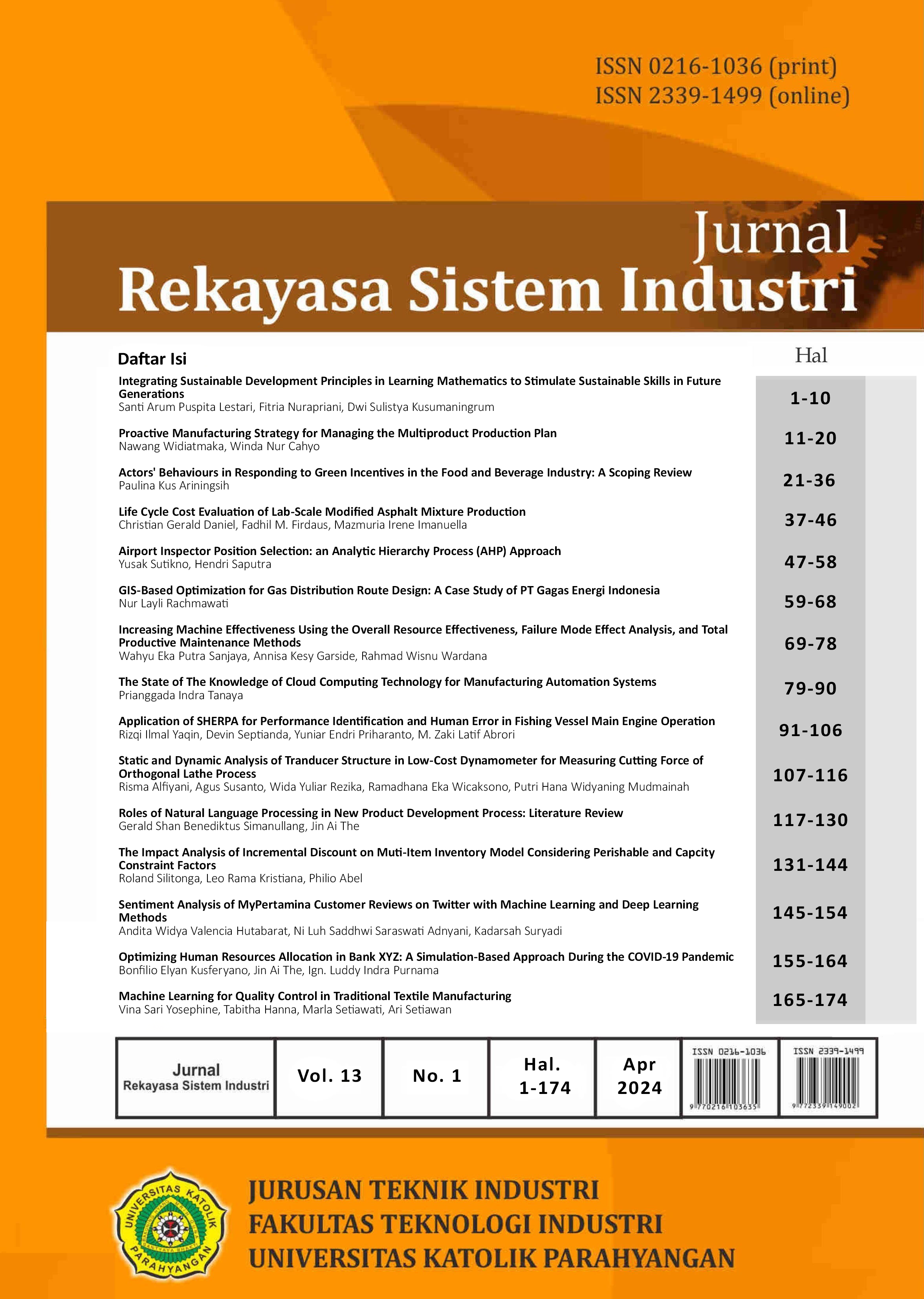Proactive Manufacturing Strategy for Managing the Multiproduct Production Plan
DOI:
https://doi.org/10.26593/jrsi.v13i1.7188.11-20Keywords:
flexibility manufacturing strategy, proactive manufacturing strategy, quality management, Pareto, fault tree analysisAbstract
The case study focuses on a multi-product company in Indonesia that aims to develop a proactive manufacturing strategy to tackle production disruptions caused by process uncertainty. Data from 30 periods are analyzed to evaluate the company's weekly production plan performance, revealing consistent quantity fulfillment but significant discrepancies in the types of products produced compared to the plan. Process uncertainty, especially regarding quality, leads to disruptions such as uneven and inadequate material supplies. Statistical Process Control (SPC) tools, like Pareto analysis, are used to identify priority quality issues, forming the basis for Fault Tree Analysis (FTA) to trace root causes and determine intervention points. Each machine's limited set of valves and pipes poses challenges for thorough cleaning during downtime and quality management outside working hours. Introducing backup valves and pipes per machine can mitigate these issues and improve production efficiency. Companies can implement procurement strategies for pipes and valves to prevent dirty prints in the primary process, ensuring smooth material supply and minimizing disruptions. Although actual production plan achievement hasn't reached 100%, this strategy has the potential to increase product sales by 3.31% by reducing the rejection ratio of dirty prints. Ultimately, proactive procurement of spare pipes and valves is expected to increase production efficiency by 4%, indicating enhanced production schedule stability.
References
Afifa, Y. N., & Santoso, I. (2022). Proactive Risk Mitigation Strategies and Building Strategic Resilience in the Food Supply Chain: A Review. Food Research, 6(2), 9–17. https://doi.org/10.26656/fr.2017.6(2).257
Baig, A. A., Ruzli, R., & Buang, A. B. (2013). Reliability Analysis Using Fault Tree Analysis: A Review. International Journal of Chemical Engineering and Applications, 4(3), 169–173. https://doi.org/10.7763/ijcea.2013.v4.287
Bo, H., Chen, X., & Wang, R. (2021). Manufacturing Rescheduling after Crisis or Disaster-Caused Supply Chain Disruption. SSRN Electronic Journal. https://doi.org/10.2139/ssrn.3902825
Csontos, B., Halász, L., & Heckl, I. (2022). Improved Event-Driven Simulation Method for Fuel Transport in a Mesh-Like Pipeline Network. Computers and Chemical Engineering, 168(April). https://doi.org/10.1016/j.compchemeng.2022.108066
Esmaeili-Najafabadi, E., Azad, N., Pourmohammadi, H., & Fallah Nezhad, M. S. (2021). Risk-Averse Outsourcing Strategy in the Presence of Demand and Supply Uncertainties. Computers and Industrial Engineering, 151, 106906. https://doi.org/10.1016/j.cie.2020.106906
Georgiadis, G. P., Elekidis, A. P., & Georgiadis, M. C. (2021). Optimal Production Planning and Scheduling in Breweries. Food and Bioproducts Processing, 125, 204–221. https://doi.org/10.1016/j.fbp.2020.11.008
Iqbal, A., & Sarkar, B. (2020). Disruption Management in a Constrained Multi-Product Imperfect Production System. Journal of Manufacturing Systems, 56(November 2018), 227–240. https://doi.org/10.1016/j.jmsy.2020.05.015
Lee, S. Y., & Lee, J. Y. (2021). Fixing the Barn Door Before the Horse Bolts: Effects of Pre-Crisis Engagement and Stealing Thunder In Crisis Communication. Public Relations Review, 47(1), 101930. https://doi.org/10.1016/j.pubrev.2020.101930
Li, Z., Liang, Y., Liao, Q., Zhang, B., & Zhang, H. (2021). A Review of Multiproduct Pipeline Scheduling: from Bibliometric Analysis to Research Framework and Future Research Directions. Journal of Pipeline Science and Engineering, 1(4), 395–406. https://doi.org/10.1016/j.jpse.2021.08.001
Niu, B., Shen, Z., & Xie, F. (2021). The Value of Blockchain and Agricultural Supply Chain Parties’ Participation Confronting Random Bacteria Pollution. Journal of Cleaner Production, 319(April 2020), 128579. https://doi.org/10.1016/j.jclepro.2021.128579
Potkány, M., Krajčírová, L., & Stasiak-Betlejewska, R. (2021). Use of Target Costing Methodology in the Construction of Wood-Aluminium Windows - Case study. Engineering Management in Production and Services, 13(4), 148–159. https://doi.org/10.2478/emj-2021-0037
Samani, M. R. G., Hosseini-Motlagh, S. M., & Homaei, S. (2020). A Reactive Phase Against Disruptions for Designing A Proactive Platelet Supply Network. Transportation Research Part E: Logistics and Transportation Review, 140(May), 102008. https://doi.org/10.1016/j.tre.2020.102008
Sánchez-ramírez, C., Ramos-hernández, R., Fong, J. R. M., Alor-Hernández, G., & García-alcaraz, J. L. (2020). A System Dynamics Model to Evaluate the Impact of Production Process Disruption on Order Shipping. Applied Sciences, 10(1). https://doi.org/10.3390/app10010208
Stentoft, J., Adsbøll Wickstrøm, K., Philipsen, K., & Haug, A. (2021). Drivers and Barriers for Industry 4.0 Readiness and Practice: Empirical Evidence from Small and Medium-Sized Manufacturers. Production Planning and Control, 32(10), 811–828. https://doi.org/10.1080/09537287.2020.1768318
Sun, D., Huang, R., Chen, Y., Wang, Y., Zeng, J., Yuan, M., Pong, T. C., & Qu, H. (2020). PlanningVis: A Visual Analytics Approach to Production Planning in Smart Factories. IEEE Transactions on Visualization and Computer Graphics, 26(1), 579–589. https://doi.org/10.1109/TVCG.2019.2934275
Urlu, B., & Erkip, N. K. (2020). Safety Stock Placement for Serial Systems Under Supply Process Uncertainty. Flexible Services and Manufacturing Journal, 32(2), 395–424. https://doi.org/10.1007/s10696-019-09374-3
Vanzetti, N., Corsano, G., & Montagna, J. M. (2021). Integrated Scheduling of the Drying Process in a Sawmill. Computers and Chemical Engineering, 153. https://doi.org/10.1016/j.compchemeng.2021.107407
Woschank, M., Dallasega, P., & Kapeller, J. A. (2020). The impact of Planning Granularity on Production Planning and Control Strategies In MTO: A Discrete Event Simulation Study. Procedia Manufacturing, 51(2019), 1502–1507. https://doi.org/10.1016/j.promfg.2020.10.209

